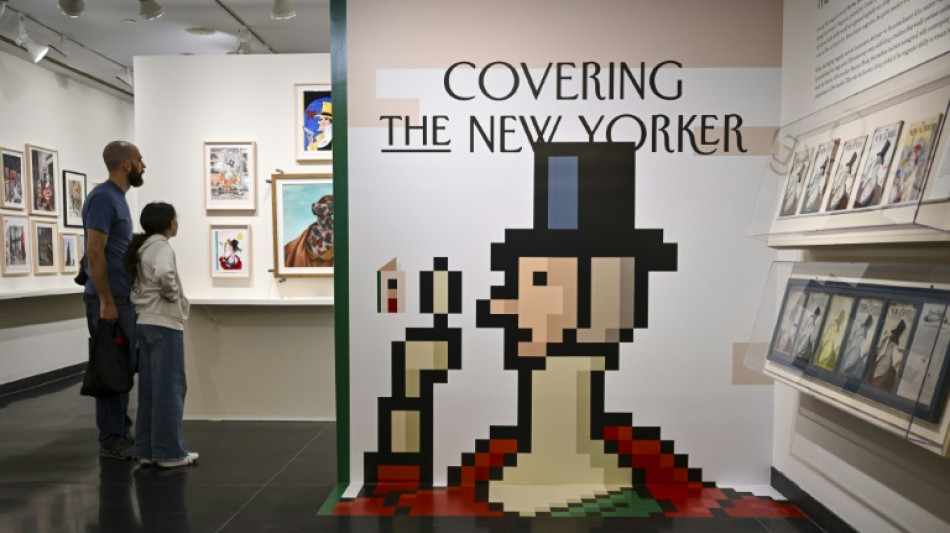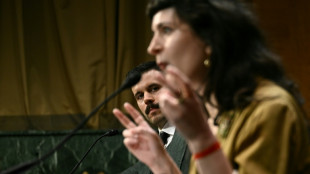
-
 The factors behind violent unrest in Nepal
The factors behind violent unrest in Nepal
-
Nepal army bids to restore order after deadly protests oust PM

-
 Trump jeered at Washington restaurant, called 'Hitler of our time'
Trump jeered at Washington restaurant, called 'Hitler of our time'
-
Jamaica, Curacao and Honduras win in World Cup qualifying

-
 Pacific Islands leaders to back 'ocean of peace' at fraught summit
Pacific Islands leaders to back 'ocean of peace' at fraught summit
-
South Korea sends plane to fetch detained workers from US

-
 Poland says 'hostile objects' downed in its airspace during Russian attack on Ukraine
Poland says 'hostile objects' downed in its airspace during Russian attack on Ukraine
-
Nepal army patrols after deadly protests oust PM

-
 Salvaged shipwreck porcelain gets new life in Malaysia
Salvaged shipwreck porcelain gets new life in Malaysia
-
EU chief to defend Trump trade deal in parliament

-
 USA blank Japan while South Koreans draw Mexico in friendlies
USA blank Japan while South Koreans draw Mexico in friendlies
-
Top Japan start-up Sakana AI touts nature-inspired tech

-
 Australia to deploy fleet of underwater strike drones
Australia to deploy fleet of underwater strike drones
-
France set for disruption as new PM takes office

-
 Asian markets rally as new US jobs data fans rate cut hopes
Asian markets rally as new US jobs data fans rate cut hopes
-
Jamaicans beat Trinidad and Tobago in World Cup qualifying

-
 Zendejas and Balogun lift USA over Japan 2-0 in friendly
Zendejas and Balogun lift USA over Japan 2-0 in friendly
-
Australia approves chlamydia vaccine for koalas

-
 Lyles leads US medal charge in Tokyo, Kipyegon eyes fourth title
Lyles leads US medal charge in Tokyo, Kipyegon eyes fourth title
-
Kidnapped academic Elizabeth Tsurkov released in Iraq

-
 'It was bananas': Colin Farrell shoots new movie in Macau casinos
'It was bananas': Colin Farrell shoots new movie in Macau casinos
-
De Minaur says Australia ready to snap Davis Cup title drought

-
 Pacific Islands leaders kick off summit clouded by China tensions
Pacific Islands leaders kick off summit clouded by China tensions
-
Obese surpass undernourished youths for first time, UN warns

-
 Pulsar to Present at the European Growth Virtual Investor Conference
Pulsar to Present at the European Growth Virtual Investor Conference
-
Presentation to Beaver Creek Precious Metals Summit

-
 Labor Smart, Inc. (OTC:LTNC) Provides Corporate Update Following Sept. 9 X Spaces Discussion
Labor Smart, Inc. (OTC:LTNC) Provides Corporate Update Following Sept. 9 X Spaces Discussion
-
Collision Clinic LTD Recognized with 2025-26 Consumer Choice Award for Automobile Body Shop in St. John's

-
 US Supreme Court to hear Trump tariff case in November
US Supreme Court to hear Trump tariff case in November
-
NBA Bulls re-sign Australian guard Giddey

-
 Former Meta researchers testify company buried child safety studies
Former Meta researchers testify company buried child safety studies
-
Trump issues rare rebuke to Netanyahu over Qatar strikes

-
 US stocks close at fresh records, digesting weak jobs data
US stocks close at fresh records, digesting weak jobs data
-
Bolsonaro on brink of conviction in Brazil coup trial

-
 England set the standard with Serbia rout: Tuchel
England set the standard with Serbia rout: Tuchel
-
Trump ready to match EU tariffs on China, India to pressure Putin: US official

-
 Hong Kong legislature to vote on same-sex partnerships bill
Hong Kong legislature to vote on same-sex partnerships bill
-
Unconvincing France come from behind to edge Iceland in World Cup qualifying

-
 England thrash Serbia, Haaland stars in World Cup qualifying
England thrash Serbia, Haaland stars in World Cup qualifying
-
Sparkling England crush Serbia to ignite Tuchel's reign

-
 Portugal edge Hungary in World Cup qualifying thriller
Portugal edge Hungary in World Cup qualifying thriller
-
Trump issues rare rebuke to Netanyahu over Qatar strike

-
 Cape Verde close to World Cup debut after beating Cameroon
Cape Verde close to World Cup debut after beating Cameroon
-
Ganguly's Pretoria team lands big-hitting Brevis for record price

-
 Apple's move to eSIM-only strengthens global trend
Apple's move to eSIM-only strengthens global trend
-
Macron names close ally Lecornu new PM

-
 Afghanistan thrash Hong Kong in Asia Cup opener
Afghanistan thrash Hong Kong in Asia Cup opener
-
Deadly Israeli strikes targeting Hamas in Qatar earn Trump rebuke

-
 Pacific Islands leaders hold summit clouded by China tensions
Pacific Islands leaders hold summit clouded by China tensions
-
Tedesco replaces Mourinho as Fenerbahce coach


The New Yorker, a US institution, celebrates 100 years of goings on
The New Yorker magazine, a staple of American literary and cultural life defined by its distinctive covers, long-form journalism, witty cartoons and particular grammar, is celebrating 100 years on newsstands.
To mark the publication's centenary milestone, four commemorative issues are being released, while its namesake city will host seven exhibitions ahead of a Netflix documentary on the title known for its artistic cover creations.
Despite its storied history, the New Yorker often puts a mirror up to current events. Three founding fathers were shown on a recent cover design being marched out of office, carrying their effects in cardboard boxes in a satirical commentary on US President Donald Trump's assault on the status quo.
Francoise Mouly, the magazine's artistic director, said the New Yorker was not immune from the crisis plaguing the media.
"But I'm stubborn and I see the future with a lot of confidence and hope," she said.
Mouly has been one of the conductors of the New Yorker orchestra since 1993, selecting the cover that week after week lends the magazine its unique identity.
"There are some printed products that will never be replaced by digital -- children's books, comics, and the New Yorker," she told AFP at a recent exhibition showcasing the magazine's art, held at New York's Alliance Francaise cultural center.
One example of cover art on display depicts a rush-hour subway scene in which all the passengers are animals, while another by Mouly's husband Art Spiegelman shows a Black woman kissing a Hasidic man.
That 1993 design, which followed clashes between the two communities in a Brooklyn neighborhood, stirred controversy at the time and remains one of the title's most discussed covers.
With more than 5,000 editions over the past century, the magazine has published literary greats like Truman Capote's 1965 "In Cold Blood", while also giving James Baldwin space to write about race relations.
- 'Incredibly successful' -
Ernest Hemingway, Susan Sontag and JD Salinger are among the authors to have graced the pages of the magazine which combines current affairs, analysis, fiction, reviews, criticism, poetry, and of course its legendary cartoons.
Published weekly, the magazine has reported global scoops like the fullest account of the US atomic bomb dropped on Hiroshima, with the entirety of the August 31, 1946 edition given over to John Hersey's article.
In 1961 Hannah Arendt covered the trial of Nazi war criminal Adolf Eichmann in the reporting of which she coined the phrase "the banality of evil."
In recent years the magazine won a Pulitzer Prize for Ronan Farrow's reporting of predatory film mogul Harvey Weinstein, fuelling the "MeToo" movement.
"These were all remarkable, long-form stories that really changed the course of American history, not just American journalism," said Julie Golia, curator of an exhibition on the magazine at The New York Public Library.
Founded on February 21, 1925, the New Yorker did not always have such lofty ambitions.
At the height of the Jazz Age, amid post-war and pre-depression euphoria, husband and wife founders Harold Ross and Jane Grant set out to create "a magazine of wit and cosmopolitanism, an urbane magazine, but not one that took itself too seriously."
One hundred years on, it boasts 1.3 million subscribers, most of whom subscribe in both print and digital formats. It is a jewel in the crown of media group Conde Nast, which also publishes Vogue, Vanity Fair and GQ, having bought the New Yorker in 1985.
Despite its highbrow image, the magazine has adapted to the digital age emphasizing subscriptions over advertising, editor-in-chief since 1998 David Remnick said in a recent radio interview.
"The New Yorker is much more than those pages that people get in the mail," said Golia.
"It's a website, it's podcasts, it's a festival, and it's a brand (and) as a brand, it's incredibly successful."
C.Garcia--AMWN

